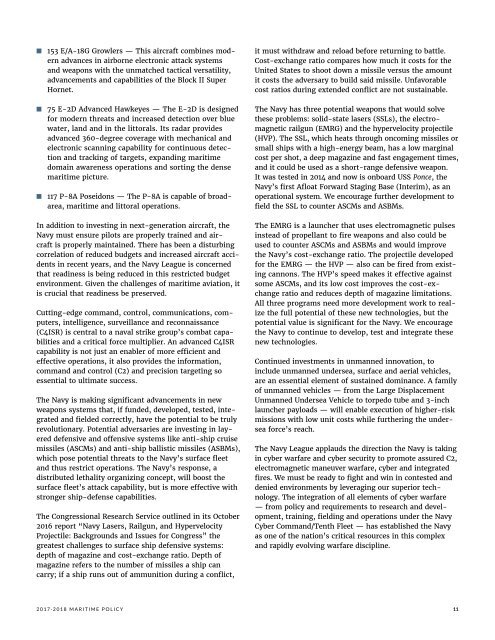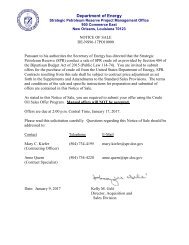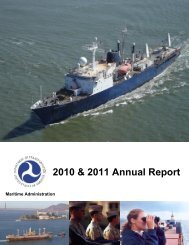Create successful ePaper yourself
Turn your PDF publications into a flip-book with our unique Google optimized e-Paper software.
n 153 E/A-18G Growlers — This aircraft combines modern<br />
advances in airborne electronic attack systems<br />
and weapons with the unmatched tactical versatility,<br />
advancements and capabilities of the Block II Super<br />
Hornet.<br />
n 75 E-2D Advanced Hawkeyes — The E-2D is designed<br />
for modern threats and increased detection over blue<br />
water, land and in the littorals. Its radar provides<br />
advanced 360-degree coverage with mechanical and<br />
electronic scanning capability for continuous detection<br />
and tracking of targets, expanding maritime<br />
domain awareness operations and sorting the dense<br />
maritime picture.<br />
n 117 P-8A Poseidons — The P-8A is capable of broadarea,<br />
maritime and littoral operations.<br />
In addition to investing in next-generation aircraft, the<br />
Navy must ensure pilots are properly trained and aircraft<br />
is properly maintained. There has been a disturbing<br />
correlation of reduced budgets and increased aircraft accidents<br />
in recent years, and the Navy League is concerned<br />
that readiness is being reduced in this restricted budget<br />
environment. Given the challenges of maritime aviation, it<br />
is crucial that readiness be preserved.<br />
Cutting-edge command, control, communications, computers,<br />
intelligence, surveillance and reconnaissance<br />
(C4ISR) is central to a naval strike group’s combat capabilities<br />
and a critical force multiplier. An advanced C4ISR<br />
capability is not just an enabler of more efficient and<br />
effective operations, it also provides the information,<br />
command and control (C2) and precision targeting so<br />
essential to ultimate success.<br />
The Navy is making significant advancements in new<br />
weapons systems that, if funded, developed, tested, integrated<br />
and fielded correctly, have the potential to be truly<br />
revolutionary. Potential adversaries are investing in layered<br />
defensive and offensive systems like anti-ship cruise<br />
missiles (ASCMs) and anti-ship ballistic missiles (ASBMs),<br />
which pose potential threats to the Navy’s surface fleet<br />
and thus restrict operations. The Navy’s response, a<br />
distributed lethality organizing concept, will boost the<br />
surface fleet’s attack capability, but is more effective with<br />
stronger ship-defense capabilities.<br />
The Congressional Research Service outlined in its October<br />
2016 report “Navy Lasers, Railgun, and Hypervelocity<br />
Projectile: Backgrounds and Issues for Congress” the<br />
greatest challenges to surface ship defensive systems:<br />
depth of magazine and cost-exchange ratio. Depth of<br />
magazine refers to the number of missiles a ship can<br />
carry; if a ship runs out of ammunition during a conflict,<br />
it must withdraw and reload before returning to battle.<br />
Cost-exchange ratio compares how much it costs for the<br />
United States to shoot down a missile versus the amount<br />
it costs the adversary to build said missile. Unfavorable<br />
cost ratios during extended conflict are not sustainable.<br />
The Navy has three potential weapons that would solve<br />
these problems: solid-state lasers (SSLs), the electromagnetic<br />
railgun (EMRG) and the hypervelocity projectile<br />
(HVP). The SSL, which heats through oncoming missiles or<br />
small ships with a high-energy beam, has a low marginal<br />
cost per shot, a deep magazine and fast engagement times,<br />
and it could be used as a short-range defensive weapon.<br />
It was tested in 2014 and now is onboard USS Ponce, the<br />
Navy’s first Afloat Forward Staging Base (Interim), as an<br />
operational system. We encourage further development to<br />
field the SSL to counter ASCMs and ASBMs.<br />
The EMRG is a launcher that uses electromagnetic pulses<br />
instead of propellant to fire weapons and also could be<br />
used to counter ASCMs and ASBMs and would improve<br />
the Navy’s cost-exchange ratio. The projectile developed<br />
for the EMRG — the HVP — also can be fired from existing<br />
cannons. The HVP’s speed makes it effective against<br />
some ASCMs, and its low cost improves the cost-exchange<br />
ratio and reduces depth of magazine limitations.<br />
All three programs need more development work to realize<br />
the full potential of these new technologies, but the<br />
potential value is significant for the Navy. We encourage<br />
the Navy to continue to develop, test and integrate these<br />
new technologies.<br />
Continued investments in unmanned innovation, to<br />
include unmanned undersea, surface and aerial vehicles,<br />
are an essential element of sustained dominance. A family<br />
of unmanned vehicles — from the Large Displacement<br />
Unmanned Undersea Vehicle to torpedo tube and 3-inch<br />
launcher payloads — will enable execution of higher-risk<br />
missions with low unit costs while furthering the undersea<br />
force’s reach.<br />
The Navy League applauds the direction the Navy is taking<br />
in cyber warfare and cyber security to promote assured C2,<br />
electromagnetic maneuver warfare, cyber and integrated<br />
fires. We must be ready to fight and win in contested and<br />
denied environments by leveraging our superior technology.<br />
The integration of all elements of cyber warfare<br />
— from policy and requirements to research and development,<br />
training, fielding and operations under the Navy<br />
Cyber Command/Tenth Fleet — has established the Navy<br />
as one of the nation’s critical resources in this complex<br />
and rapidly evolving warfare discipline.<br />
2017-2018 <strong>MARITIME</strong> POLICY 11




